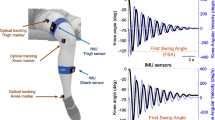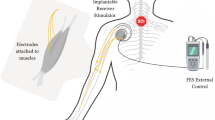Abstract.
Mechanical changes underlying spastic hypertonia were explored using a parallel cascade system identification technique to evaluate the relative contributions of intrinsic and reflex mechanisms to dynamic ankle stiffness in healthy subjects (controls) and spastic, spinal cord injured (SCI) patients. We examined the modulation of the gain and dynamics of these components with ankle angle for both passive and active conditions. Four main findings emerged. First, intrinsic and reflex stiffness dynamics were qualitatively similar in SCI patients and controls. Intrinsic stiffness dynamics were well modeled by a linear second-order model relating intrinsic torque to joint position, while reflex stiffness dynamics were accurately described by a linear, third-order system relating half-wave rectified velocity to reflex torque. Differences between the two groups were evident in the values of four parameters, the elastic and viscous parameters for intrinsic stiffness and the gain and first-order cut-off frequency for reflex stiffness. Second, reflex stiffness was substantially increased in SCI patients, where it generated as much as 40% of the total torque variance, compared with controls, where reflex contributions never exceeded 7%. Third, differences between SCI patients and controls depended strongly on joint position, becoming larger as the ankle was dorsiflexed. At full plantarflexion, there was no difference between SCI and control subjects; in the mid-range, reflex stiffness was abnormally high in SCI patients; at full dorsiflexion, both reflex and intrinsic stiffness were larger than normal. Fourth, differences between SCI and control subjects were smaller during the active than the passive condition, because intrinsic stiffness increased more in controls than SCI subjects; nevertheless, reflex gain remained abnormally high in SCI patients. These results elucidate the nature and origins of the mechanical abnormalities associated with hypertonia and provide a better understanding of its functional and clinical implications.
Similar content being viewed by others
Author information
Authors and Affiliations
Additional information
Electronic Publication
Rights and permissions
About this article
Cite this article
Mirbagheri, .M., Barbeau, .H., Ladouceur, .M. et al. Intrinsic and reflex stiffness in normal and spastic, spinal cord injured subjects. Exp Brain Res 141, 446–459 (2001). https://doi.org/10.1007/s00221-001-0901-z
Received:
Accepted:
Issue Date:
DOI: https://doi.org/10.1007/s00221-001-0901-z




